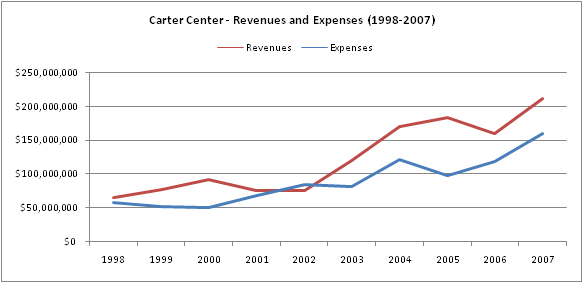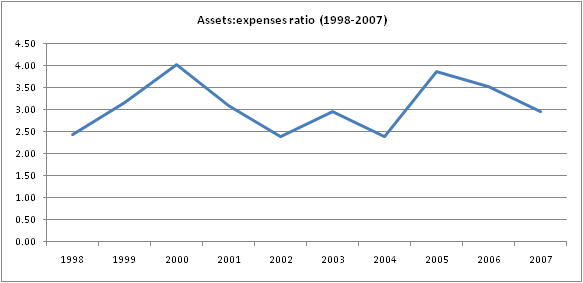In Part I, I laid out my case for The Carter Center, and why we think they’re worth investigating deeply. I also said that we’re not yet ready to recommend them because we have some unanswered questions. Here they are:
Relevance of your donation
When I give, I want to know that the organization needs my support and is going to accomplish more good (than they otherwise would have) because of my support. Because of The Carter Center’s strong track record, I wonder whether they can already effectively raise all the money they want. That is, I wonder whether money isn’t the bottleneck to serving more people. That question is supported by looking at Carter’s current financial situation. Revenues have risen roughly in-line with expenses over the past few years (see chart 1 below), maintaining their (relatively large) assets:expense ratio of 3:1 (see chart 2, below). All data comes from Carter Center annual reports, available on their website here.


Many of The Carter Center’s programs have extremely strong independent evidence supporting them (e.g., their guinea worm, river blindness, lymphatic filariasis, and schistosomiasis programs). These programs also have the type of strong, consistent monitoring I mentioned in the previous post. However, the evidence case for some of their other programs is weaker (in particular their trachoma, agriculture, and public health training initiative), and the monitoring provided for those programs is both a) less consistent and b) less compelling than the monitoring provided for the others.
Running some less-proven projects doesn’t necessarily mean we won’t recommend them, especially if those programs are relatively small, but:
Lack of financial transparency
The Carter Center is one of the (if not the) most transparent organizations I’ve ever come across when it comes to monitoring their activities. Carter not only lays out what they do in extreme detail — for the intrepid, the most recent river blindness program report (PDF) is representative of Carter Center monitoring — they discuss program trade-offs they make, lessons they’ve learned, and potential future obstacles. But, they don’t publish any cost data on their website, other than the very broad and general 990 data and some sporadic program-specific information. To properly evaluate The Carter Center, we need to know the portion of the budget that’s allocated to any less-proven programs. In addition, we want tell you what your donation accomplishes to The Carter Center. Does $1,000 prevent 1 case of blindness? 2? 10? We need better information on costs to make that call.
Those are the questions we’re working on answering now. Whatever we find, you’ll get our answers soon.

Comments
A couple comments:
1) Cost/cure doesn’t really apply well when a program aims to eradicate a disease, as, if I understand correctly, at least some Carter Center initiatives attempt to do.
While a given amount of money may pay for a certain number of preventative treatments, and, in turn, we might estimate that for every N preventative treatments, X cases of the disease are prevented, it’s hard to figure out how to easily apply that type of analysis to the potential eradication of a disease from a region of even worldwide.
2) I’m skeptical of the idea that the Carter Center (or just about any other well run charity) is so awash in funding that they don’t need anymore. Yes, it’s hard for me to say that my donation of $100 or $100,000 or whatever is the only thing that keeps the charity going. Obviously, they have a lot of funding already. But if they are particularly efficient and effective in turning dollars donated into excellent results, then I think it’s reasonable to assume that additional marginal dollars donated (i.e. MY potential donation) will probably be more effective here than at a different charity with a weaker track record.
Full disclosure – I’m already a big fan of The Carter Center, have donated significantly to them in the past and likely will donate more to them in the future.
Thinking about this a bit more…
I suppose the question “do they have enough money already?” is relevant when one looks at the micro picture – certain specific programs of TCC. It seems likely to me that where they’ve already had great success (i.e. Guinea Worm) that full eradication may, at this point, be less a function of additional funding than of the difficulties of reaching the last pockets (which may be in part because of political, logistical, or other issues).
Still, while incremental donations may not, at this point, have much effect on Guinea Worm treatments, I think it’s reasonable to guesstimate the effectiveness of donations (likely directed heavily towards newer programs) by the effectiveness they’ve achieved in the past (i.e. with older programs).
That said, it might be true that they’ve already picked some of the low hanging fruit. One of their programs, which I think is a somewhat newer one, is a health training program for Ethiopia that looks reasonable, but probably not likely (in my perhaps naive opinion) to achieve as striking of results as the Guinea Worm campaign.
Regarding cost-effectiveness analysis: I agree that the cost per case averted isn’t as simple to calculate for eradication efforts, but I still think trying to tell a donor what a program costs and what its likely impacts are is essential, notwithstanding the the fact that the calculation requires a slightly different approach. I’m guessing there’s some cost at which you wouldn’t support guinea worm eradication.
Regarding the relevance of one’s donation: I don’t have the same intuition as you regarding charities likely need for additional funding to maintain their core activities. The Carter Center’s public health training initiative may be good, or it may not be. But, I’m impressed with Carter based on its other programs, not this one. (Not to mention peace programs which are much harder to evaluate.) If those programs are utilizing the bulk of additional funds, I wouldn’t’ be confident donating further.
I agree with you that given the Carter Center’s track record and the information they make available, they are likely among the more effective international aid charities. But, personally, I’m not content with “better than the others” — I want to know whether I should a) give at all and b) give to this cause. For that, I want to know how additional funds will be used.
Comments are closed.